Is sushi healthy?
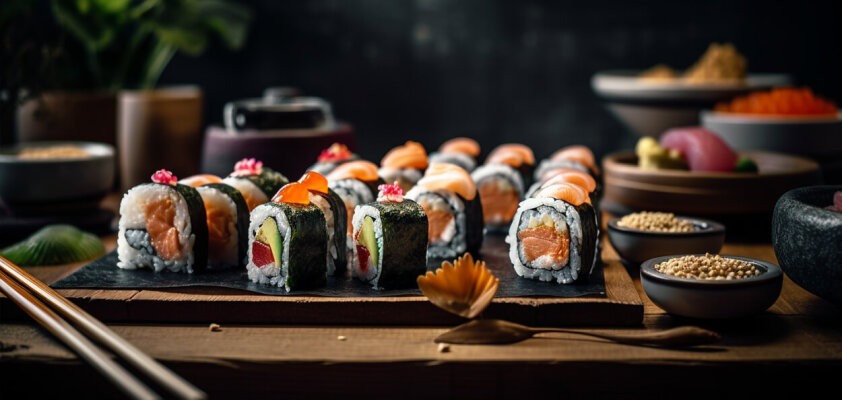
Inhaltsverzeichnis
Japanese cuisine between fitness and indulgence Sushi with fish: healthy or dangerous? Vegetarian recipes for sushi without fish The supporting cast: wasabi, soy sauce and co. Particularly healthy: vegetables from the sea Hidden sugar in sushi rice Healthy eating made easy with sushiFresh, fresher, Sushi: The combination of raw fish, sticky rice, vegetables, and seaweed is considered a healthy and nutritious meal. However, the Japanese specialty not only has fans – it is claimed that eating sushi also has its drawbacks. We have investigated the matter: Is sushi healthy?
Japanese cuisine between fitness and indulgence
Not everyone may appreciate seaweed, raw fish, and rice soaked in vinegar. Nevertheless, Sushi is becoming increasingly popular: More and more restaurants offer the Japanese delicacy, and sushi recipes, found in restaurants and online, are becoming more numerous and diverse. There is now sushi to suit almost every taste. Whether it is particularly healthy is a matter of debate – or is it not?
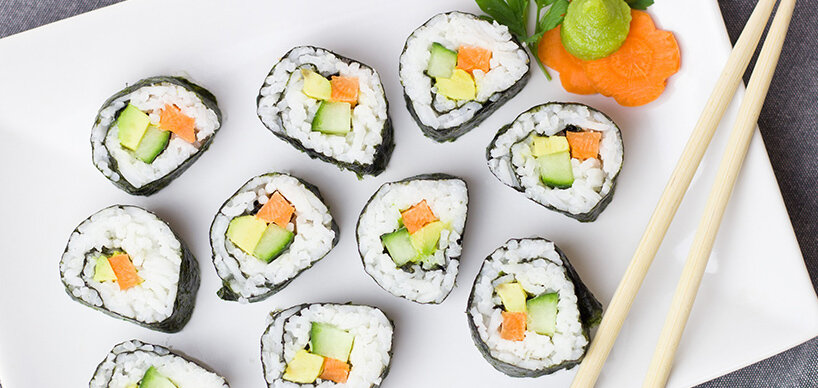
A light, versatile meal with little fat and calories that is also filling – this is often the reputation of Sushi in our culture, and it is frequently transformed into recipes for weight loss or even low-carb recipes. Moreover, it is made with valuable ingredients. In sushi with rice, fish, and vegetables, there is indeed a lot of healthy content: for example, fish provides a good amount of protein, Omega-3 fatty acids, iodine, and Vitamin D. However, special attention should be paid to this component of sushi.
Sushi with fish: healthy or dangerous?
Critics say: The seas are overfished and contaminated with pollutants. Unfortunately, this is true – but one does not have to give up on fish, just shop consciously to minimize the harm to the body and nature as much as possible. First of all, it helps to choose crabs, trout, herring, carp, and plaice instead of tuna, bass, or eel, as these species are neither highly endangered nor carry toxins like mercury. By-catch is also lower in these cases. Moreover, products with environmental and quality seals such as FOS, Naturland, or ASC should be preferred. This is especially true for species like bonito (tuna) from the can, shrimp, and pollock, where it is crucial how they were caught or bred. If you do a little research, you are doing something good for the environment and your health.
The other source of danger with fish is the freshness: Raw fish poses dangers such as worms and bacteria. If you buy it yourself, it should be common sense to refrigerate the fish well and consume it soon or freeze it alternatively. Special caution is required at the sushi buffet, as the portions there often sit out for a long time. Pay attention to whether the sushi with fish is adequately chilled or covered. Do not eat anything that has a brownish color, looks slimy, or smells suspicious. Especially with sashimi, thin slices of raw fish, or nigiri, where the fish is placed directly on top of pressed rice, the quality can be well recognized.
Vegetarian recipes for sushi without fish
For fish-free sushi, there is, of course, always the alternative of vegetable sushi: cucumber, avocado, radish, bell pepper, pumpkin, or arugula – almost anything rich in vitamins and healthy proteins can be stuffed into the rice roll. There are plenty of vegetarian and vegan recipes for healthy eating, for example, online. However, one should not be too easily deceived here either: with cream cheese or deep-fried on the outside, the healthy meal can quickly turn into a calorie bomb.
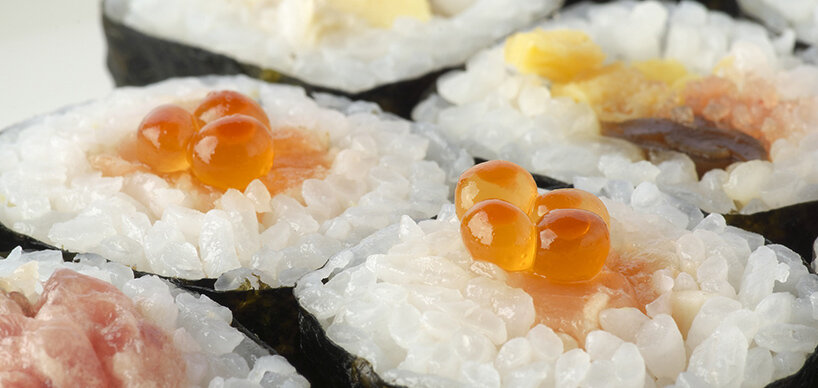
Omelette and tofu are great ingredients for vegetarian sushi. Whether on top of the rice in Nigiri, in the Maki roll, or on the outside: important sources of protein that taste good can also be found here. Fried tofu filled with rice is often found in sushi restaurants under the name Inari. But sesame, with its healthy oils and fats, is also a kind of superfood that is often used in sushi.
The supporting cast: wasabi, soy sauce and co.
Sushi rarely comes alone. We often enjoy the rolls with soy sauce, wasabi, ginger, and miso soup. While the quantities are small, it doesn't hurt to take a closer look at these popular sushi accompaniments.
Conventional soy sauce often contains many additives such as dyes, preservatives, and flavor enhancers. Traditional soy sauce, despite the high salt content, is quite healthy in itself: proteins, antioxidants, and amino acids contribute significantly. Wasabi, which is available in tubes, often contains many additives. Additionally, it's rarely real wasabi but only a small percentage mixed with horseradish, mustard, and cornstarch. Nevertheless, the spiciness not only adds a piquant flavor but also aids in digestion.
Ginger is also stimulating for metabolism and, due to its minerals, makes a good addition to the sushi platter. Interestingly, in Japan, it is rarely served in sushi restaurants. However, the pickled variant also contains a considerable amount of sugar in the ginger, so one should not overdo it with this accompaniment.
As an appetizer, miso soup is a good choice: a broth with Wakame seaweed, sesame, tofu, and other ingredients. An appetizer that packs a punch: especially the seaweed in it is full of health benefits.
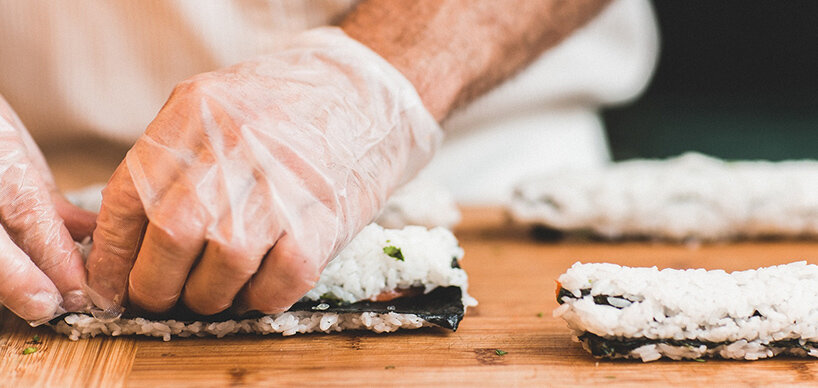
Particularly healthy: vegetables from the sea
If you don't like fish but still want to benefit from its healthy effects, you will particularly appreciate the "wrapper" around the sushi: the nori seaweed. All types of sushi involving seaweed are called Maki. Seaweed can be used in various ways in sushi: it can be wrapped around the outside of the Hosomaki or Futomaki roll (thin or thick sushi roll), as in Uramaki, wrapped around the ingredients before the rice is added outside, along with sesame seeds or caviar, or as in Temaki, formed into a pointed cone and then filled with ingredients. In Gunkanmaki, the ingredients, usually caviar, fish roe, corn, or Wakame seaweed, are placed in a small boat made of Nori, where they rest on a thin bed of rice. Hence the name: "Battleship Maki."
The Nori seaweed, like fish, is rich in Omega-3, vitamins, minerals, and protein. It also contains fewer calories than all the other ingredients in sushi. And you will benefit from this, even if only about 2.5g of a sheet is used per sushi roll. Those who don't like seaweed may not notice much of its flavor.
Hidden sugar in sushi rice
The intense flavor of sushi also comes from the vinegar added to the sticky rice after cooking. What was once a way to preserve the ingredients in sushi for as long as possible now gives the unique taste to this Japanese specialty. Rice vinegar itself is mild and excellent for healthy digestion. But what about the rice?
Even though white rice is eaten throughout the day in Japan – unlike sushi, which is a Japanese delicacy – it contains many calories in the form of short-chain carbohydrates. Similar to sugar, these are quickly broken down into glucose, leading to fluctuations in blood sugar levels, and hunger returns quickly. Brown rice, on the other hand, contains long-chain carbohydrates that provide a longer feeling of satiety and are not stored as quickly. Additionally, it is not polished, so the naturally occurring minerals, fiber, and vitamins are preserved. So, why not try preparing the next maki roll with brown rice?
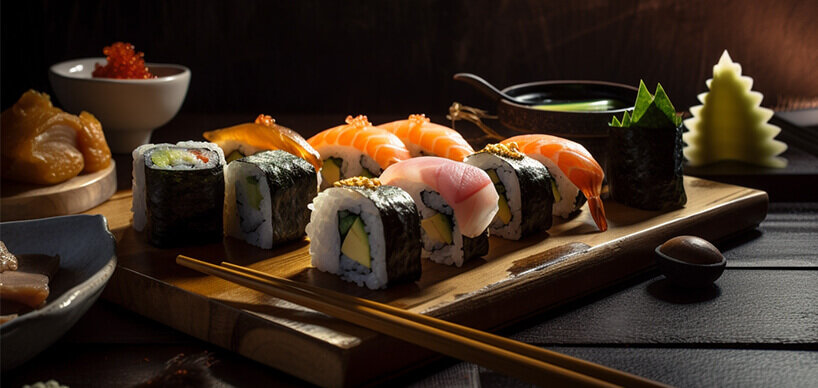
Healthy eating made easy with sushi
The following tips can help incorporate sushi into a healthy diet and fitness routine without sacrificing taste:
- Less white rice: It's not that easy, as sushi needs a lot of rice to hold together. Therefore, thin rolls like Hosomaki, the Gunkanmaki boat, or even Temaki, the "sushi cone," are optimal – this achieves the low-carb effect. Brown rice is also a healthy alternative.
- Include healthy ingredients in the rolls: The more vegetables and seaweed, the more vitamins, healthy oils, and fiber you get. Moreover, the ingredients can be wonderfully varied.
- Choose fish in sushi that is not overfished or contaminated. Also, only buy and eat fresh raw fish! Tofu and fried egg are wonderful alternatives.
- Less is more: Try to avoid fried and milky components – then the sushi has fewer calories, and the enjoyment is a delight for both the palate and the body.
- When it comes to condiments like soy sauce and wasabi, ensure they contain as few additives as possible – then they taste much better without unnecessarily burdening the body.











-from-the-yakiyaki-grill-pan.jpg)




